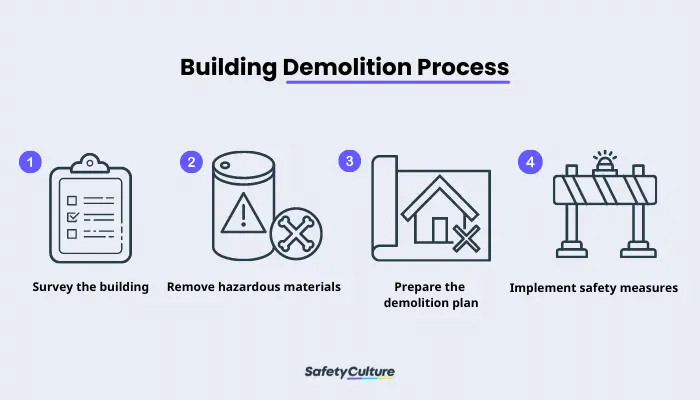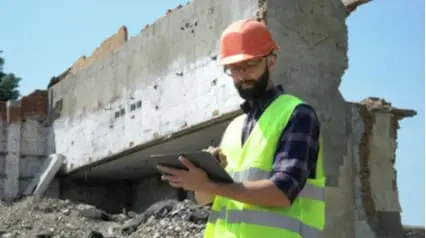What is Building Demolition?
Building demolition is the process of dismantling, destroying, or knocking down building structures along with the materials used in the construction of the property. A building is demolished for various reasons such as: it’s past its span of serviceability, the structural integrity is compromised, parts of the establishment will need to be refurbished to improve its quality and value, or the property owner intends to sell a vacant lot.
If a building is not demolished when it needs to be, it can pose a significant threat and endanger not just the people occupying the property, but others in the vicinity as well. According to the Occupational Safety and Health Administration (OSHA), proper planning is crucial to ensuring that building demolitions are conducted without injuries and accidents.
Building Demolition Methods
There are many things to consider when planning to demolish a building—such as the structure, location, materials used, strength of the building, and threats that it may pose if wrongfully executed. Finding the best method before proceeding with the plan is the most important element in ensuring a safe demolition process.
Demolition methods are divided into two categories and further classified into demolition types. They are as follows:
Non-explosive method
Non-explosive method is a demolition technique that uses hand tools and machinery. It is best used to dismantle smaller- to medium-sized structures like homes or other establishments. This method includes the use of:
- Sledge hammer
- Bulldozers
- Wrecking balls
- Standard and high-reach excavators
Implosive method
Implosive method is a type of demolition technique that uses explosives to destroy the structural supports of the building and make it collapse. It is best used to dismantle a building or structure with significant height. The two ways to do this are:
- Falling like a tree (i.e., the building is imploded and made to fall sideways)
- Falling into its own footprint (i.e., the building is imploded and made to collapse on itself)
Demolition Process
Building demolition should be done according to a set process and involve several phases. Follow the steps below on how to demolish a building safely and systematically:

1. Survey the building
Industry professionals should check all of the elements of the property such as the construction materials, design, usage of building prior to demolition, and building codes. There should also be a review of the preference of the nearby neighborhood to noise and dust, as well as other possible impacts of these kinds of activities to the community.
Additionally, the building should be checked for the presence of hazardous, toxic, radioactive, or flammable materials. Structurally, the building should be inspected for the method of construction, current structural condition, and structural system and design.
This way, it would be easier to determine which methods to use in demolishing the property, safely and efficiently.
2. Remove hazardous materials
If hazardous materials such as asbestos minerals, radioactive substances, and flammable materials are found in the initial inspection, industry experts should be deployed to remove them safely before proceeding to the demolition.
3. Prepare the demolition plan
A detailed plan on how the demolition is best executed should be developed. The demolition plan should contain specifics on which demolition methods to use in each part of the building along with the sequence of how it should be carried out.
Supporting details such as the location of the building and its distance from other structures and roads, as well as from vulnerable zones such as schools and hospitals, should be indicated.
The demolition plan should also mention all the measures on how to manage health, safety, and waste disposal before, during, and after the demolition.
4. Implement safety measures
All involved personnel should discuss preventive measures and engage in toolbox talks to ensure a safe, efficient, and unified approach to the demolition procedure.
Additionally, proper and consistent usage of demolition safety signs should be observed. Workers should also wear the appropriate Personal Protective Equipment (PPE) at all times when in the vicinity of the structure.
Failure to comply with the above-mentioned reminders and other essential safety measures can lead to various consequences including exposure to hazardous chemicals, occurrence of flash fire, or development of occupational disease.
Improve your EHS Management
Cultivate a safe working environment and streamline compliance with our EHS solutions.
Explore nowHow to Ensure Safety During Building Demolition
Aside from choosing the right demolition method and following the demolition process, supervisors, site managers, and other personnel should also take note of the following control measures to ensure a safe building demolition:
Conduct an asbestos inspection
Asbestos inspection is vital in eliminating employee exposure to asbestos minerals and should be done before altering any parts of the structure. This inspection should specifically be conducted by a certified asbestos inspector to ensure that it’s done safely and according to the set standards.
Manage waste disposal
Managing waste disposal is required by law to protect the health and safety of the public and the environment. As the demolition and construction industry is one of the contributors to solid wastes, proper waste management is essential in making sure that all wastes and construction debris—especially those that are hazardous—are disposed of properly.
Incorporate risk assessment
A detailed and comprehensive planning stage of the demolition process enables all site supervisors and other involved personnel to be one step ahead. In an industry prone to hazards, performing risk assessments is fundamental in identifying possible project setbacks and in addressing them proactively. Assessments help ensure that those identified risks are managed accordingly and significantly reduce the chance of untoward incidents.
Demolition supervisors can also integrate the concept of the hierarchy of controls in eliminating hazards and risks, and in ensuring a safe working environment for their team.
Communicate with your team
People on-site directly witness day-to-day operations so they would know best what precautions should be taken and which issues should be prioritized. Encourage a steady stream of communication within the team to promote transparency and eliminate incidents caused by a lack of proper communication.
Implement OSHA guidelines
The demolition industry can further safeguard their operations by adhering to the detailed demolition standards provided by OSHA. This set of standards includes resources for primary demolition standards, as well as references from the relevant construction industry.
Perform regular inspections
Ensure that all standards, procedures, and regulations are followed and consistently practiced by performing regular inspections. This helps maintain employee compliance across-the-board and enables teams to address any issues identified before they negatively impact the project.
Train your team efficiently and adequately
One of the most effective ways to promote safety during a building demolition achieve is through regular safety training. A good building demolition safety training includes a rundown on personal safety, equipment safety, toolbox talks, standards to follow, and other safety necessities. With a solid understanding of safety, it becomes second nature for them. This can give you peace of mind knowing that everyone is working together to create a safe and secure workplace environment.
Safe Demolition with SafetyCulture (formerly iAuditor)
Building demolitions should be done according to a set process and standard. It should also be streamlined from start to end to reduce the likelihood of demolition-related accidents.
SafetyCulture is a digital safety platform that offers high-level visibility. Ensure safety in all parts of the demolition process with SafetyCulture. Move away from pen-and-paper inspections to efficiently perform essential audits and eliminate inaccuracy. Further safeguard building demolition using SafetyCulture to do the following:
- Conduct asbestos inspections, waste management inspections, risk assessments, and daily demolition site inspections using digital checklists and forms. Find other templates which may be relevant to your business in our Public Library.
- Capture images/media directly during inspections and operational checks using your mobile phone or tablet.
- Communicate effectively with your team and promote transparency and teamwork using Heads Up.
- Create corrective actions, report issues, and immediately assign them to the relevant personnel for timely resolutions.
- Train employees on safe and compliant building demolition processes
- Manage the status of your assets anytime and anywhere
- Store inspections, audits, and other documents with cloud-based recordkeeping.




